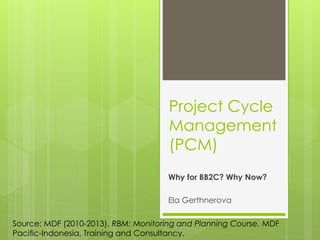
PCM Project Cycle Management Guide
- 1. Project Cycle Management (PCM) Why for BB2C? Why Now? Ela Gerthnerova Source: MDF (2010-2013). RBM: Monitoring and Planning Course. MDF Pacific-Indonesia, Training and Consultancy.
- 2. PCM Presentation Outline Evolution of the concept Why do we need it? What is it exactly? Phases of PCM Format of the documents & example Logical Framework Matrix Limitations of PCM instruments & procedures Further readings
- 3. Evolution Throughout history of development cooperation (40+ years) - difficulties to be fully satisfied with the results of the interventions (projects, programmes) Need to learn from the past experience to better perform in the future – this is the objective of Project Cycle Management (PCM) Addressing the real needs of the beneficiaries Analysis of the existing situation → stakeholders´ participation→ ownership creation.
- 4. PCM: Why do we need it? An approach to ease communication and to improve decision-making Effective & efficient funds utilization Determines our intervention results in both technical and organizational nature Determines the project/programme performance and impact (measurability) Increases organizational credibility in the eyes of donors
- 5. What is PCM? 1) LEARNING APPROACH 2} INSTRUMENT 3} ADMINISTRATIVE ORGANIZATION Involves Beneficiaries – clear problem analysis on the project plan is developed Create Framework for Learning – involving users and all actors Adhere to the phases of the project cycle Plan for sustainability in planning process Logical Framework (LF) = tool for consistent and complete project design and management Logical Framework is the precise description of project objectives, it is easier to appraise and improves monitoring LF consists of: Impact/Outcomes/Outp uts/Activities; Indicators, Assumptions-Risks and Pre-conditions Gains efficiency and improves the communication and co- ordination Transparent and clear flow of the documents at each stage of the PCM Procedures and regulations – consultations, meeting structure, frequency Quality and motivation of all experts and desk officers dealing with the project analysis
- 7. I. Indicative Programming Includes specific aid thematic focuses in a country Sets out a number of ideas for projects or programmes Includes policy guidelines or strategic framework of a recipient country (government)
- 8. II. Identification/Pre-feasibility Concerns the initial formulation of a project/programme idea in terms of objectives, results and activities Determines whether it is worthwhile to do a feasibility study If yes – drawing Terms of Reference for the study
- 9. III. Appraisal/Financing Drafting financial proposals Examination A comparative appraisal by a financing committee (if there is one) Drafting and signing of a financing agreement
- 10. IV. Implementation Concerns the execution of the project/programme (usually drawing on the resources provided by the financing agreement) Aims to achieve desired results and the purpose of the project/programme Various reports are produced: inception report or plan of operations, annual work plans and monitoring reports/field visits reports.
- 11. V. Evaluation The results and impact of the project/programme are analyzed The evaluation part can start during the implementation phase It is used to recommend possibilities for corrections If done after implementation, it formulates recommendations how to improve guidance for similar interventions
- 12. Format of the Documents Used in PCM Standardized format (both writers and readers) Chapters & headings are the same, terms are clearly defined what aspects are addressed and fixed Based on Logical Framework matrix Different donors use similar form of logical framework A donor’s example of the documents needed (contd.)
- 13. PCM: EC Format Example 1. Summary 5. Implementation 5.1. Physical and non-physical means 5.2. Organization and implementation procedures 5.3. Timetable 5.4. Cost-estimate and financing plan 5.5. Special Conditions (Govt. Measures) 2. Background 2.1. Government/sector policy 2.2.Features of sector 2.3.Beneficiaries and parties involved 2.4.Problems to be addressed 2.5.Other interventions 2.6. Documentation available 6. Factors Ensuring Sustainability 6.1. Policy Support 6.2. Appropriate Technology 6.3. Environmental Protection 6.4. Socio-cultural aspects(Gender) 6.5. Institutional and Management Capacity (public, private) 6.6. Economic and financial analysis 3. Intervention • 3.1. Overall objectives • 3.2. Project Purpose • 3.3. Intermediate Results • 3.5. Activities 7. Monitoring and Evaluation 7.1. Monitoring indicators 7.2. Reviews/evaluations 4. Assumptions 4.1. Assumptions at different levels 4.2. Risks and flexibility 8. Conclusions and Proposals
- 14. The Logical Framework Matrix Logic Indicators Sources of Verification Assumptions/ Risks Impact Outcomes Outputs Activities Pre- conditions
- 15. Limitations of PCM instruments and Procedures PCM alone cannot guarantee successful results of our projects/programmes! Valuable for those who prepare and control the implementation of the projects Available information has to be of high quality Planners, implementers and and beneficiaries have to be genuinely committed
- 16. Misunderstandings of PCM PCM is not just a formal exercise resulting in a blue-print for a project/programme It is a result of analysis at a certain point in time Necessary to always adapt the plan to the changing situation!
- 17. Further Readings NORAD (1999). Logical Framework Approach (LFA). Handbook for Objectives-Oriented Planning. Fourth edition. European Commission (2004). Aid Delivery methods. Project Cycle Management Guidelines: Supporting effective implementation of EC external assistance. Volume 1. EC & ITAD (1999). Project Cycle Management Training Handbook. Version 1